高中英语第一课
- 格式:ppt
- 大小:9.04 MB
- 文档页数:2
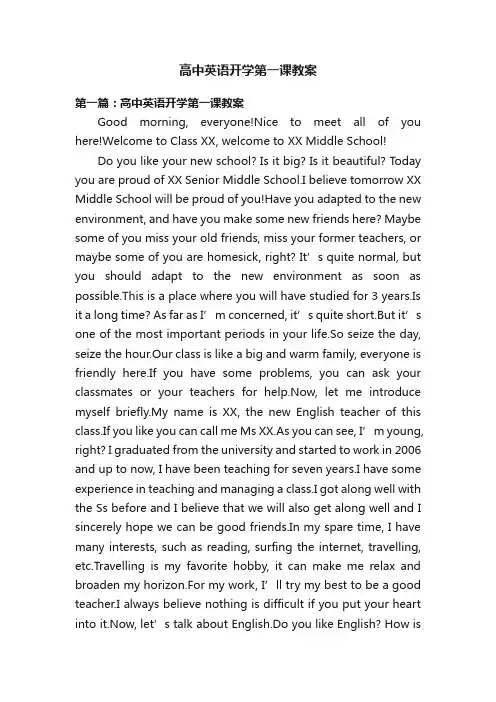
高中英语开学第一课教案第一篇:高中英语开学第一课教案Good morning, everyone!Nice to meet all of you here!Welcome to Class XX, welcome to XX Middle School!Do you like your new school? Is it big? Is it beautiful? T oday you are proud of XX Senior Middle School.I believe tomorrow XX Middle School will be proud of you!Have you adapted to the new environment, and have you make some new friends here? Maybe some of you miss your old friends, miss your former teachers, or maybe some of you are homesick, right? It’s quite normal, but you should adapt to the new environment as soon as possible.This is a place where you will have studied for 3 years.Is it a long time? As far as I’m concerned, it’s quite short.But it’s one of the most important periods in your life.So seize the day, seize the hour.Our class is like a big and warm family, everyone is friendly here.If you have some problems, you can ask your classmates or your teachers for help.Now, let me introduce myself briefly.My name is XX, the new English teacher of this class.If you like you can call me Ms XX.As you can see, I’m young, right? I graduated from the university and started to work in 2006 and up to now, I have been teaching for seven years.I have some experience in teaching and managing a class.I got along well with the Ss before and I believe that we will also get along well and I sincerely hope we can be good friends.In my spare time, I have many interests, such as reading, surfing the internet, travelling, etc.Travelling is my favorite hobby, it can make me relax and broaden my horizon.For my work, I’ll try my best to be a good teacher.I always believe nothing is difficult if you put your heart into it.Now, let’s talk about English.Do you like Engli sh? How isyour English? I hope all of you are good at English, your English is good, great, excellent, learning English is interesting, easy, just a piece of cake.Learning English is China’s most sad behavior, but we have to learn it.There are many reasons for us to learn English well.First, English is an international language and it is the most widely used language in the world, according to the statistics, every one in ten people speak English.It has been said that over 75% of the word’s TV programs and80% of the information on the internet use English.With the development of our country, more and more foreigners come to China and more and more Chinese are going abroad.The communication of foreigners and us needs the language tool---English.Secondly, English is one of the most important subjects at school or the university.If you want to get good marks and want to enter a good university in three years, you must learn it well.Thirdly, your influence English can help you get a better job in the future, if you can learn English well, you will have more chances to succeed.Fourthly, English has been used everywhere in our daily life.For example,你英语如果能考150分(学生笑), 那你就太酷(cool)了,I’ll take you to KFC,吃汉堡包(hamburger), 喝咖啡(coffee)可乐(cola), 坐巴士(bus)去打高尔夫(golf)保龄球(bowling).你喜欢天天向上这种脱口秀(talk show)还是中国好声音PK赛又或者是NBA?这些节目都有很多忠实的粉丝(fans)。
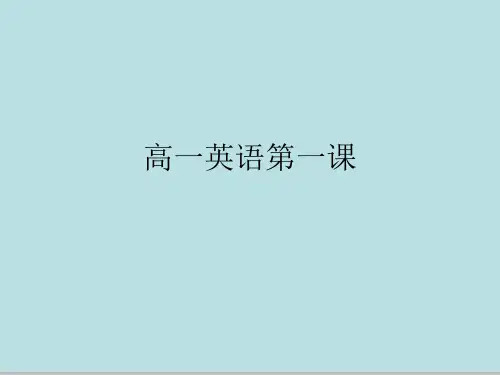

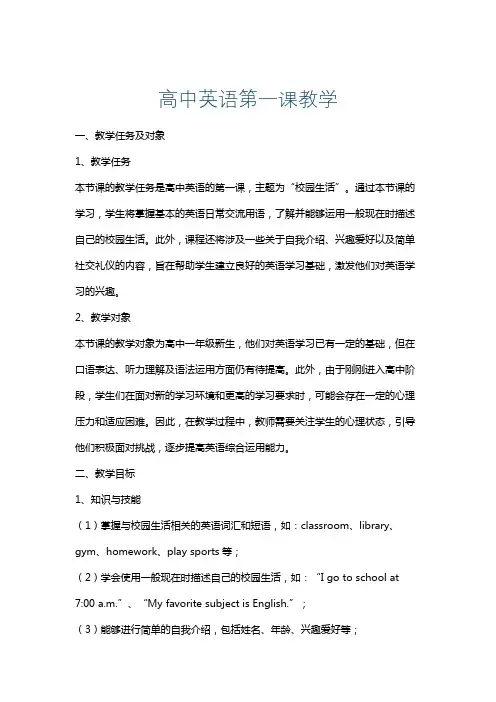
高中英语第一课教学一、教学任务及对象1、教学任务本节课的教学任务是高中英语的第一课,主题为“校园生活”。
通过本节课的学习,学生将掌握基本的英语日常交流用语,了解并能够运用一般现在时描述自己的校园生活。
此外,课程还将涉及一些关于自我介绍、兴趣爱好以及简单社交礼仪的内容,旨在帮助学生建立良好的英语学习基础,激发他们对英语学习的兴趣。
2、教学对象本节课的教学对象为高中一年级新生,他们对英语学习已有一定的基础,但在口语表达、听力理解及语法运用方面仍有待提高。
此外,由于刚刚进入高中阶段,学生们在面对新的学习环境和更高的学习要求时,可能会存在一定的心理压力和适应困难。
因此,在教学过程中,教师需要关注学生的心理状态,引导他们积极面对挑战,逐步提高英语综合运用能力。
二、教学目标1、知识与技能(1)掌握与校园生活相关的英语词汇和短语,如:classroom、library、gym、homework、play sports等;(2)学会使用一般现在时描述自己的校园生活,如:“I go to school at 7:00 a.m.”、“My favorite subject is English.”;(3)能够进行简单的自我介绍,包括姓名、年龄、兴趣爱好等;(4)提高英语听力水平,能理解并回应关于校园生活的日常对话;(5)培养良好的英语发音和口语表达能力,提高课堂互动的积极性。
2、过程与方法(1)采用情景教学法,让学生在实际语境中学习英语,提高语言的实践运用能力;(2)运用任务型教学法,引导学生通过小组合作完成任务,培养团队协作能力和解决问题的能力;(3)利用多媒体教学资源,如视频、音频等,丰富课堂教学内容,提高学生的学习兴趣;(4)鼓励学生参与课堂讨论,培养他们的思维能力和表达能力;(5)关注学生的个体差异,因材施教,使每个学生都能在课堂上获得进步。
3、情感,态度与价值观(1)培养学生对英语学习的兴趣,使他们树立自信心,勇于面对英语学习中的困难;(2)通过小组合作学习,让学生学会尊重和理解他人,培养团结互助的精神;(3)引导学生树立正确的价值观,认识到学习英语的重要性,激发他们为国家和民族的繁荣而努力学习;(4)关注学生的心理健康,营造轻松愉快的课堂氛围,使学生在愉悦的情感中学习英语;(5)培养学生具备良好的学习习惯和自主学习能力,为终身学习奠定基础。
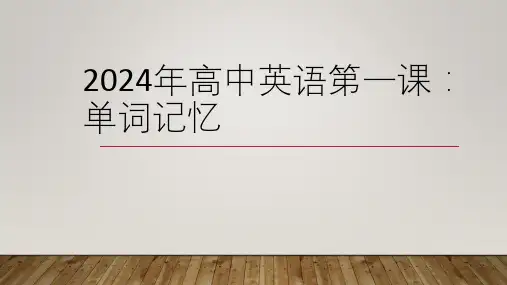
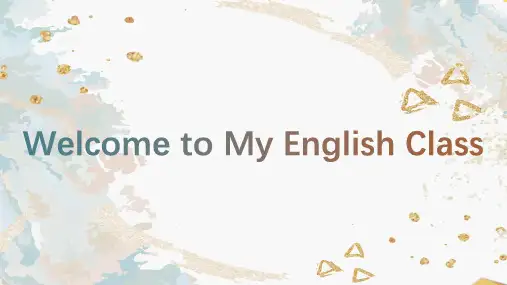

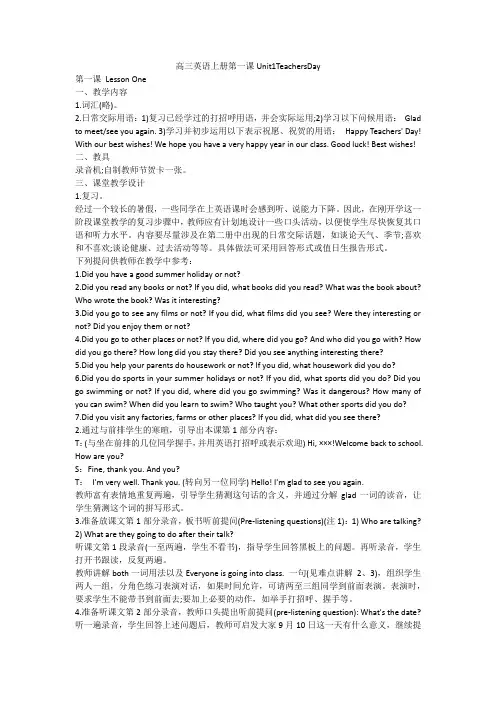
高三英语上册第一课Unit1TeachersDay第一课Lesson One一、教学内容1.词汇(略)。
2.日常交际用语:1)复习已经学过的打招呼用语,并会实际运用;2)学习以下问候用语:Glad to meet/see you again. 3)学习并初步运用以下表示祝愿、祝贺的用语:Happy Teachers' Day! With our best wishes! We hope you have a very happy year in our class. Good luck! Best wishes!二、教具录音机;自制教师节贺卡一张。
三、课堂教学设计1.复习。
经过一个较长的暑假,一些同学在上英语课时会感到听、说能力下降。
因此,在刚开学这一阶段课堂教学的复习步骤中,教师应有计划地设计一些口头活动,以便使学生尽快恢复其口语和听力水平。
内容要尽量涉及在第二册中出现的日常交际话题,如谈论天气、季节;喜欢和不喜欢;谈论健康、过去活动等等。
具体做法可采用回答形式或值日生报告形式。
下列提问供教师在教学中参考:1.Did you have a good summer holiday or not?2.Did you read any books or not? If you did, what books did you read? What was the book about? Who wrote the book? Was it interesting?3.Did you go to see any films or not? If you did, what films did you see? Were they interesting or not? Did you enjoy them or not?4.Did you go to other places or not? If you did, where did you go? And who did you go with? How did you go there? How long did you stay there? Did you see anything interesting there?5.Did you help your parents do housework or not? If you did, what housework did you do?6.Did you do sports in your summer holidays or not? If you did, what sports did you do? Did you go swimming or not? If you did, where did you go swimming? Was it dangerous? How many of you can swim? When did you learn to swim? Who taught you? What other sports did you do?7.Did you visit any factories, farms or other places? If you did, what did you see there?2.通过与前排学生的寒暄,引导出本课第1部分内容:T:(与坐在前排的几位同学握手,并用英语打招呼或表示欢迎) Hi, ×××!Welcome back to school. How are you?S:Fine, thank you. And you?T:I'm very well. Thank you. (转向另一位同学) Hello! I'm glad to see you again.教师富有表情地重复两遍,引导学生猜测这句话的含义,并通过分解glad一词的读音,让学生猜测这个词的拼写形式。


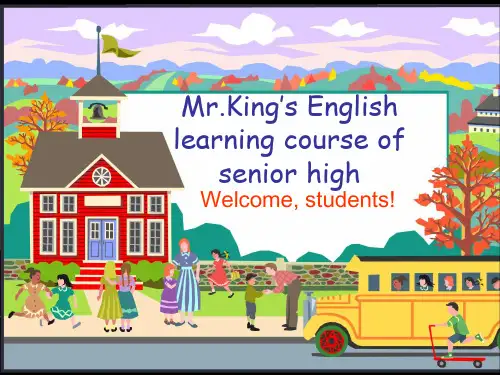
高中英语第一课教案5篇教学中,备课是一个必不可少、极其重要的环节,备课不充分或者备得不好,会严重影响课堂的气氛和学生的积极性,一堂准备充分的课,会令学生和老师都获益非浅。
因此,平时,我紧抓备、教、改、辅、查等教学中的重要环节。
以下是我带来的高中英语第一课教案内容,感谢您的阅读,希望能援助到您!高中英语第一课教案1Lesson Plan InterpretationNSEFC Book1 Unit3 Travel JournalHello, everyone. It’s an honor for me to stand here and interpret my lesson. The lesson plan I am going to talk about is from NSEFC Book 1 Unit 3 Travel Journal. I’ll explain how to teach and why do so from the following 5 aspects: the theoretical basis, understanding of the teaching material, teaching methods and studying ways, teaching procedure, blackboard design.Ⅰ. The theoretical basisFirst, I’d like to show my theoretical basis--schema theory and top-down model (Goodman, 1971). Journey down the Mekong is a reading course. According to schema theory, reading prehension is an interactive process between the reader’s background knowledge and the text (Carrel and Eisterhold, 1983), or between the new information and the old knowledge store (Anderson and Pearson, 1984). So in order to improve the students’ reading speed and reading prehension, language teachers should try to activate the Ss’ old knowledge store and add more relevant background knowledge before they get the students to read. According to the top-down model, general idea of the text will be got first, and then e the details.II. Understanding of the teaching materialMy understanding of the teaching material includes 3 parts: the status and the function, teaching objectives, the important and difficult points.At the beginning, let’s focus on the first part. Journey down the Mekong is a piece of travel journal written by Wang Kun. It’s mainly about Wang Kun and his sister’s dream of taking a great bike trip down the Mekong River, their preparation for the trip and some more details of the Mekong River. General speaking, it is not difficult for the students to understand thetext, but there are some new phrases and sentences that may be a little bit difficult. So before the students’ first reading, I will explain the new words and phrases briefly and after reading the whole passage, I will embody the usage of the news words and phrases, and get the student understand the difficult sentences. As it is a piece of journal, besides learning the new words and phrases, students can get the general idea of how to write a journal.That’s all for the first part, now let’s move to the second part. According to the teaching material and the new curriculum of English, in order to fulfill the learning task of this lesson, I establish the following objectives:a) Knowledge objectivesBy the end of the lesson, Ss will have a better understanding of the meaning and structure of the text. Then Ss will grasp some useful words and expressions such as determined, make up one’s mind, give in, be fond of …, care about…, stubborn, etc.b) Ability objectivesActually students should be encouraged to do speed reading in the first period of reading lesson. But the students in my class are lack of independent reading ability. In this class, Iwill encourage and help them to read, think and find out information by themselves most time. Since the main objective of reading course is to improve the Ss’ reading ability, I’ll train their ability of identifying the general idea in the fast reading. And in intensive reading their ability of information-gathering and summarizing is developed. And the whole class is for Ss to develop their reading skills as scanning, skimming, information-gathering, summarizing and guessing the new words from the text.c) Moral objectivesThough Journey down the Mekong is mainly about the trip down the river, it also talks about the scenery and life along the river. So before learning the text, we will have a short discussion about the importance of the river. I want the Ss to have the awareness of protecting the river and protecting our environment.Well, so much for the teaching objectives, lets e to deal with the third part: the important points and the difficult points. According to the national curriculum of English and language learning theory, when teaching reading, we should encourage the Ss to do speed reading for the first time, that’s to say, we should encourage our Ss to read as fast as they can when theydo the first reading. So much emphasis should be put on reading skills and reading prehension as well. So the important points are that how to make Ss grasp the new words and phrases and how to improve their reading skills as scanning, skimming, information-gathering and summarizing. As to the difficult points, they are the same as the important ones.III. Teaching methods and studying waysThat’s all for my understanding of the teaching material. Now let’s focus on the ways of teaching and learning.Generally speaking, I adopt task-based language teaching and municative approach in my class. As for learning, Ss will learn through independent reading, discussing and cooperating.I will use puter and blackboard as my teaching aids.Ⅰ. Teaching procedureHere es the most important part, the teaching procedure. It includes 5 steps: Step I: Lead-in andpre-reading, Step II: While-reading, Step III: Consolidation, Step IV: Post-reading, Step V: Homework.Step I: Lead-in and pre-reading (7mins)Now let’s e to the first step. There are three activities in this step and I will spend 7mins on them.In activity one, I will ask Ss two questions Do you know some great rivers in China? and Why they are great?” Here, asthe Ss get familiar with the Chinese great rivers, I choose to ask them some great rivers in China. And the answer to the second question can lead in the next activity--brainstorming.In activity two, I will ask the Ss to discuss in pairs and answer the question How do people who live along a river use it?” My purpose of this activity is to remind the Ss the importance of the river, thus stimulate the Ss awareness of protecting the rivers.In the last activity, I will show the Ss a picture of the Mekong River and ask them to list the countries that it flows through. This activity leads in the while-reading.Step II: While-reading (21mins)While-reading is the main part and it will take 21mins. Here I adopt the top-down reading model. This step is divided into 2 parts: fast reading and careful reading. Before reading, I will ask the Ss to predict what will talk in the text according to the title. It can exert the Ss imagination.1) Fast readingDuring fast reading, I will ask the Ss to reading the whole passage quickly and get the main idea of each paragraph. Usually, the main idea of each paragraph is the first sentence or the last sentence, but this text is not. So the main idea of eachparagraph will be matched because the Ss are lack of the skill of summarizing the main idea by themselves.2) Careful readingAfter getting the general idea of each Para., I will deal with the details Para. by Para..In paragraph one, I will ask the Ss to read quickly and do the exercises T or F. And if it is F, I will ask them to correct it. This exercise can help the Ss get the key information of the first paragraph in a short time and can deepen the Ss’ understanding of the first paragraph.In paragraph two, I will ask Ss one question “Is it a difficult journey to cycle along the Mekong? Why?” This can help the Ss develop their ability of summarizing. If the Ss can’t answer the question briefly, I will encourage them to find the key sentences and try to join them together.And in the last paragraph, I will ask Ss two questions “How does the water of Mekong River change?” and “What can you see when you travel along the Mekong River?” Both questions are required to answer in keys word. In order to lower the difficulty of the questions, I will show them the examples. After that, I will present some pictures to deepen the Ss’ impression on the new words. And these two questions can help the Ssgain a deeper understanding on the Mekong River.Step III: Consolidation (6mins)After dealing with the detailed information of each paragraph, I will ask the Ss to read the whole passage again and answer two questions to consolidate what they’ve learnt. It will take 6 minutes. The two questions are “Where is the source of the Mekong River and which sea does it enter?” and “How do Wang Kun and Wang Wei prepare for the trip?” It is easy for the Ss to find the answer to the first question in the text. As to the second question, it may be a little difficult, so I will list some tips for the Ss to find the answer more easily.Step IV: Post-reading (10mins)That’s all for the while-reading. Now let’s move to the fourth step. In this step, I will design two activities and I will spend 10 minutes on them.The first activity is filling in the blanks. In this activity, Ss are required to find the different attitudes of Wang Kun and Wang Wei to the trip, and then the teacher will express her attitude to this trip. After demonstrating, Ss are encouraged to express their attitudes. It can help the Ss train their ability of information-gathering and expression.The second activity is thinking. In this activity, I will ask theSs to discuss in groups of four and try to use some words to describe the characteristics of Wang Kun and Wang Wei according to their attitudes. It is really difficult, but it can not only train their ability of analysis and prehension, but also cultivate their spirit of cooperationStep V: Homework (1min)Finally it es to the homework. Ss are required to review the learnt lesson and underline the useful words and phrases in the text. This one is for them to consolidate what they’ve learnt and make preparation for the next lesson—Learning about the Language..Ⅰ. Blackboard designOn the top, there is the title of this lesson. On the left, it lists some important roles that the river plays. On the right, there are some useful words and expressions.That’s all for my interpretation. Thank you for your att高中英语第一课教案2一. 教材内容分析本单元的中心话题是“电影”,本课是第三课时,是一篇传记体的短文,介绍当前好莱坞最有影响的导演艺术家—史蒂芬斯皮尔伯格的创作生涯和一些作品。
高中英语开学第一课一、课程导入1. 热身活动:教师组织学生进行简短的热身活动,例如英语歌曲演唱、英语口语游戏等,以此调动学生的英语学习兴趣和积极性。
2. 自我介绍:教师邀请每位学生用英语进行自我介绍,包括姓名、年龄、爱好等,帮助学生熟悉彼此,同时锻炼英语口语表达能力。
二、课程目标与要求1. 知识目标:掌握基本的英语语法、词汇和句型,能运用所学知识进行简单的英语交流。
2. 能力目标:提高英语听说读写能力,培养良好的英语学习习惯和自主学习能力。
3. 情感目标:激发学生对英语学习的兴趣,增强学习动力,培养学生的合作意识和团队精神。
三、课程内容1. 英语语法:讲解英语基本语法规则,如时态、语态、句型结构等,结合实例进行讲解。
2. 词汇学习:学习并掌握与高中英语课程相关的基础词汇,如家庭成员、学校生活、兴趣爱好等。
3. 对话练习:设置情景对话,让学生分角色进行练习,提高英语口语表达能力。
4. 阅读理解:选取适合高中生的英语文章,进行阅读理解训练,提高阅读速度和理解能力。
四、教学方法1. 任务型教学法:通过设置任务,引导学生积极参与,培养自主学习能力。
2. 情境教学法:创设真实的语言环境,让学生在实际语境中学习和运用英语。
3. 互动教学法:鼓励学生之间、师生之间的互动交流,提高英语听说能力。
五、课程评价1. 平时成绩:考察学生在课堂上的表现,如出勤、作业、课堂参与度等。
2. 期中考试:全面检测学生对课程内容的掌握程度,包括语法、词汇、听说读写等方面。
3. 期末考试:结合期中考试,全面评估学生的英语水平,检验教学效果。
六、课后作业1. 语法练习:布置与课程内容相关的语法练习题,巩固所学知识。
2. 词汇积累:要求学生课后积累一定数量的英语词汇,提高词汇量。
3. 阅读训练:推荐适合学生的英语文章,进行课后阅读训练。
4. 口语练习:设置口语作业,鼓励学生与家人、朋友用英语进行交流。
(注:本文仅展示全文的五分之一内容。